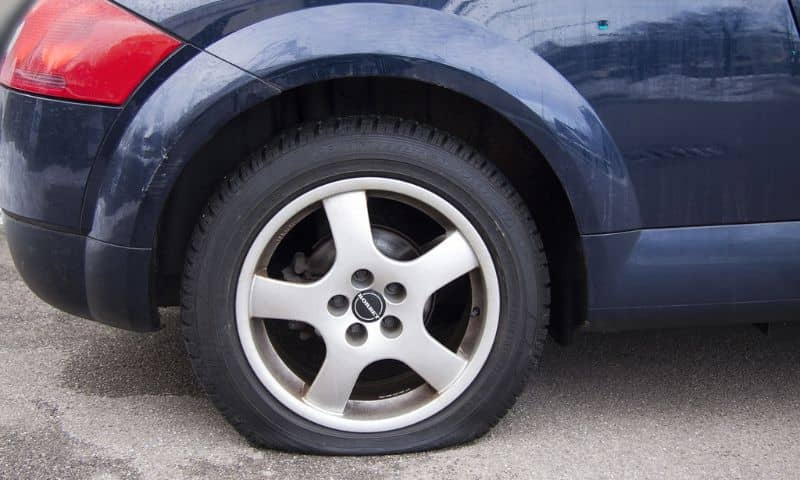
Am I At Fault for a Car Accident if My Tire Blew Out?
It’s every driver’s nightmare — one of your tires blows out while you’re driving, sending your car out of control. You ended up in a car accident that didn’t seem to be your fault. Or was it? Could you have prevented that tire blowout somehow?
After dealing with police reports, insurance claims, and car repairs, you likely have a lot of questions.
Does a tire blowout automatically make the accident your fault? Are you responsible for the damage? What if the tire seemed fine – how were you supposed to know?
What Exactly Causes Tires to Blowout
While enduring 40,000+ miles of scorching heat, rugged terrain, and heavy loads, even the best commercial truck and passenger car tires accumulate damage eventually. Tiny fractures in rubber expand into ruptures, given the right trigger conditions.
Several factors accelerate internal structural decay, including:
- Underinflation: Driving on underfilled tires flexes sidewalls excessively, generating internal heat buildup that degrades components.
- Punctures & Damage: Curb scratches, potholes, debris cuts, and improper repairs trigger air loss plus enable further tearing forces entering wounds.
- Improper Overloading: Exceeding vehicle weight capacities overstress tires beyond limits, speeding deterioration.
- Manufacturer Defects: Air pockets, weakened rubber, imbalanced tread designs, or belt misalignments prompt premature blowout-prone conditions even in new tires.
Can Tire Blowout Accidents Be Prevented?
While randomly suffering manufacturer-related blowouts proves difficult, drivers do control key prevention measures, including:
- Routine Tire Inspections: Check inflation pressures monthly and inspect tread/sidewalls for embedding debris, irregular wear patterns, or surface cracking from weathering damage. Keep routine maintenance records, these records can help defend you if you are found liable for the accident.
- Proactive Tire Replacement: Replace tires showing substantial wear or age over six years old. Heat, sunlight, and oxidation degrade components over time regardless of tread depth. Here again, keep records of tire replacement in the event your insurance company wants to see proof of tire age.
Factors That Determine Liability After Blowouts
When a tire erupts unexpectedly, especially at highway speeds, preventing an auto accident seems impossible. So, what factors determine fault afterward?
Driver Negligence for Poor Maintenance
Knowingly operating a vehicle with worn, underinflated tires constitutes negligence. Failure to inspect your tires and poor record keeping can be used to show negligence in a tire blowout case.
When defending clients in tire blowout cases, we take great care to establish that a lack of maintenance records alone does not prove negligence or establish liability. While poor record keeping may be used to argue negligence, it is very difficult to demonstrate definitively that a driver knew a tire would blow out without evidence of an active leak, bulge, gash, or other visible indicator prior to the incident.
Manufacturer Defects and Recall Accountability
Alternatively, internal tire defects causing blowouts shift accident fault onto makers like Cooper, Michelin, and Goodyear. But, securing compensation requires confirming the ruptured component suffered deficiencies. Such deficiencies cause reduced tire pressure, thin tread, and many other defects that can cause you to lose control of the car.
Attorneys demand forensic tire analyses, scanning for design flaws like weak internal steel belting, rubber abnormalities, or uneven tread wear patterns. Such evidence proves production negligence, strengthening injury demands.
Additionally, researching pending government safety recalls related to blowout-prone models bolsters claims. Manufacturers face heavy culpability when knowingly selling hazardous products later subjected to consumer warnings or sales suspensions.
Gathering Evidence to Support Your Injury Claim
Since multiple parties potentially contribute towards blowout mishaps, victims must gather impartial, indisputable proof demonstrating fault origins for insurance resolutions or lawsuits.
Individuals often overlook parties that could be held liable; this is why you call Miley Legal for a free consultation. As a knowledgeable law firm, our accident attorneys uncover every possible liable party in your tire blowout accident.
Documenting Crash Details
Have police fully diagram accident sites, record vehicle resting positions, aggregate witness statements, and document any notable road defects possibly implicated. Photograph apparent tire damage plus all scene perspectives. Seek potential video surveillance capturing the incident from area security or traffic cameras too.
Inspecting the Failed Tire Forensically
Retain the ruptured wheel assembly rather than immediately repair/replace it. Experts can analyze physical tire conditions, searching for manufacturing abnormalities like belt edge separations or irregular interior aging.
They extract essential defect evidence or reveal past damage from nails, potholes, etc., that impacted integrity.
Consulting Personal Injury Lawyers
Before insurance companies pin fault, call Miley Legal for a free consultation. Our attorneys will thoroughly investigate the accident and all personal injury claims in the case.
We know how showing that other parties are liable for the tire blowout requires case-specific experience in reconstruction and physics. Blowout liability involves technical complexity. Don’t let confusion stall fair compensation or enable victim-blaming.
Contact Miley Legal today so tire failure doesn’t cause irreparable financial damages. Justice awaits.

